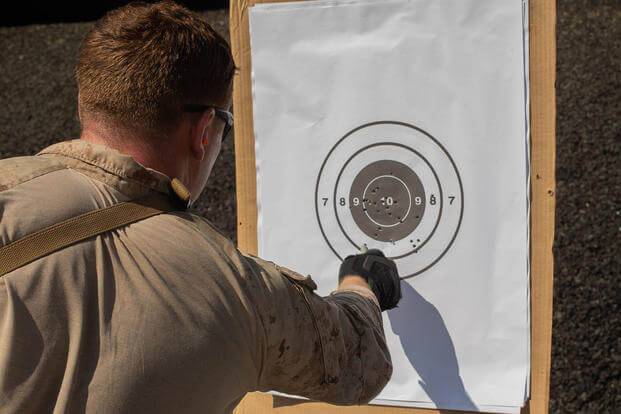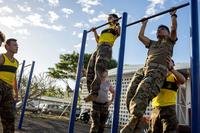Many military members leave the military to attend federal law enforcement training programs. Though many of the fitness standards are similar, some have different tests than the standard military PFT by adding sprints, jumps, shuttle runs and weightlifting tests.
Here is an email from an FBI candidate who failed the FBI physical fitness test the first time around.
"Stew, I wish I had used your FBI PFT workout about 10 weeks ago, but I am on it now and seeing good results. However, I am still having issues with the runs and the sit-ups. What do you recommend to do in addition to the workout you wrote?"
There are a few things you can supplement with the "FBI Academy Workout Plan," but most of it is learning how to take the test. Think of it as studying for the college SATs. Remember learning how to take those tests. Your scores got better, but did you really get any smarter? No, you just had a strategy and an understanding of how the test worked.
The same holds true for physical fitness testing. Think of this article of the Barron's Guide to the PFT.
Pre-test eating plan
I like to eat and drink foods with good carbohydrates in them for immediate energy. I have seen big success with apples and baby carrots for physical tests, but many people like chocolate milk in addition to a high complex-carb, pre-test power snack about an hour before testing. Do not try this on test day without testing it on a practice test, as it may or may not be the right fuel for you.
Warmup for running and sit-ups
Warm up well with a light jog and stretch of the legs and torso to prep for the run and max sit-up test:
Event #1: Max sit-ups in one minute
I have found that if you can muscle-memory the sit-up pace you need for the goal score you want, then the one minute test is a lot easier. Where people fail is that they sprint the first 30 seconds of the sit-up test and fail to match the score for the next half of the one-minute test.
For example, a FBI candidate came to me after failing the test and only scored 40 sit-ups in one minute. After explaining he needed to pace himself on the test, he scored 50 sit-ups in one minute. He did not work out or get any stronger. He simply learned how to take the test.
Here is how I recommend taking the sit-up test. Say your goal is 55 sit-ups in one minute. That is almost one per second, so at 15 seconds, you should have 14 sit-ups. Keep that pace the entire test, and you will score 55-56 sit-ups.
The same person above had more than 20 sit-ups in the first 15 seconds when he failed with 40 sit-ups, so pacing is the way to go. Also another tip: Let gravity take you to the down position. Try to relax the abdominal muscles momentarily as you fall, only to exert yourself while going up.
Good sit-up/run workout:
- Do 3-4 sets of 15 seconds of sit-ups at goal pace.
- Rest with a 300-meter run between each set.
When that becomes easy, do 3-4 sets of 30 seconds of sit-ups at goal pace. Build up to 45 and 60 seconds of sit-ups, so your pace matches your goal score.
Top score pace -- one sit-up in one second -- 60 sit-ups in one minute
Stretching your legs
After the sit-up test, take a minute to stretch the legs. Do a few squat jumps (2-3) to warm up the sprint muscles and loosen the hamstrings and thighs. You also may want to stretch your hip flexors a bit, as the sit-ups can cause them to flex and get tight.
To stretch your hip flexors one way is to do a thigh stretch while standing. Shift your hips forward and squeeze your glute muscles together. You will feel this stretch from the hips, through the thighs and to the knees.
Event #2: 300-meter timed run
This workout tends to challenge most candidates even more than the 1.5-mile run. This is an all-out sprint, but you still can build up your pace to a full sprint over the first 100 meters. You still want to explode out of the start by staying low for the first 10-20 meters in order to get the momentum going and, by the 100-meter mark, be at a full sprint.
Pump the arms hard and straight as if your arms were riding rails of a railroad track. Many people swing their arms across their body, which will slow you down by throwing off your gait. Breathe deeply throughout your run; this will enable you to keep pushing full speed for the next 25-30 seconds.
After the run, walk it off but stretch your arms and legs. Do a few push-ups to get the blood up into the arms and ready for the push-up test. Take a few sips of a sports drink or water.
Event #3: Max push-ups in one minute
The pushup is a sprint exercise. Trying to pace push-ups tends to decrease your score as gravity has a way of taking away reps. Also, the instructors will deduct you if you are not doing full range-of-motion push-ups. Proper form: Arms straight at the top and with a 90-degree bend at the bottom of a push-up position.
As with the sit-ups, let gravity take you down so you do not waste any energy letting yourself come down too slowly.
Before the run, once again, take a few sips of sports drink or water and pace yourself as you did with the sit-up test. Find your goal pace per quarter-mile and maintain that so you reach your ultimate 1.5-mile time. Stretch your legs after a short jog to get the blood back to your legs after the push-ups pump up your upper body.
Breathe deeply, pump the legs a few times and stretch the chest, arms and shoulders to loosen the upper body prior to running. Many people run too tight or pumped up after a PT test, and you need to get the blood back to your legs.
Event #4: Timed 1.5-mile run
Pace it out. If your goal is to run 1.5 miles in 10 minutes, 30 seconds, then you need to run at a seven-minute mile pace, which translates into a 3:30 half-mile and 1:45 quarter-mile.
This takes some training and practice, but many people score better by just realizing they need to find their pace and stay there.
See related articles for detailed workouts:
- The Need for Speed
- Take 2:00 Off Your PFT Mile
- PFT - Train for the Transition
- The Proper Technique for Curl-ups
- The Push-up Push Workout
Stew Smith is a former Navy SEAL and fitness author certified as a Strength and Conditioning Specialist (CSCS) with the National Strength and Conditioning Association. Visit his Fitness eBook store if you're looking to start a workout program to create a healthy lifestyle. Send your fitness questions to stew@stewsmith.com.
Want to Learn More About Military Life?
Whether you're thinking of joining the military, looking for fitness and basic training tips, or keeping up with military life and benefits, Military.com has you covered. Subscribe to Military.com to have military news, updates and resources delivered directly to your inbox.


















